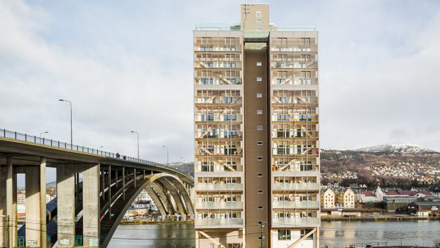
The 14-storey Treet building in Bergen, Norway, currently the world’s tallest wooden building.
Wood is all over the news — from CNN, to Forbes — as being the future of skyscrapers, but not everyone is so sure. Source: The Ubyssey
“We are on this hype of ‘Oh, timber is fantastic — aren’t we great we’re using timber?’ but that’s like a pendulum swing phenomenon,” said Perry Adebar, UBC’s civil engineering department head and an expert in high rise concrete buildings.
“Eventually, we’ll come back to being rational and we’ll use materials were they should be, and we won’t build timber buildings and cover them in drywall. We’ll be able to enjoy the beauty of the material.”
Frank Lam, senior chair professor of wood building design and construction in the faculty of forestry, had a similar view.
“The main thing for the future is two things. One of the drivers is it’s novel at the moment — architects and engineers are saying ‘I want to try it. I want to build the tallest wood building in the world,’” said Lam.
“You will see intermittent buildings like [Brock Commons] in different cities and places around the world.”
But is the future tall wood buildings? Lam isn’t so sure.
“I hope to see, through this exercise with Brock Commons, that we can see more wood buildings, not necessarily big tall ones — even four, five, six stories, office buildings is where the big market is — where the bang for the buck is,” said Lam.
Wood is a great material — it’s economical and environmental, but as Adebar emphasized, it needs to be used for the right reasons.
Wood is like a bundle of straws — very strong if you push on the ends of the straws, but very week if you bend them. Just think back to grade school when you continually snapped pencils in half by holding them just a little to tightly. How many times did you ever squish a pencil into breaking? Try it — it’s nearly impossible.
The other obvious drawback is that wood and water don’t mix well — wood rots, loses its strength and eventually decomposes and water is a very real concern (obviously) in Vancouver.
So how does Brock handle the rain?
What’s the first thing you grab before heading out on a wonderfully rainy and wet Vancouver morning? Your raincoat and boots. Brock does the same thing. Brock’s rain boots are a concrete foundation, basement and first floor.
Its raincoat is the water tight envelope that encases the building. Wood also burns more easily than concrete, is less durable and can rot if wet.
While Brock Commons and other wood buildings take precautions against these shortcomings, wood’s natural properties lend themselves to some applications better than others.
Adebar cited the fact that the wood in Brock Commons is almost entirely covered with concrete and drywall to keep it dry and away from any possible fires. But wood is probably here to stay and will continue to be used to build skyscrapers.
“Exactly how far it will go? I’m not sure,” said Adebar. “I hope we do it for the right reasons and not for the political reasons.”
Adebar argued wood should be used for purposes it’s best suited for and should be used aesthetically too. Lam, a wood expert, again agreed with Adebar.
“I was fortunate enough to go into the building and I did see the part of the dry wall,” said Lam.
“The feel between the wood exposed surface and the drywall surface is quite different. It’s unfortunate that they had to cover up all the wood.
“I don’t see us building timber structures covered in drywall. No one, I think, likes that idea.
“We need to come back to appreciating all materials and using them where they should be.”
Adebar thinks the future of construction lies in more — and better — integration of materials. Hybrid structures will use concrete, steel, wood, mass timber and glass.
These Frankensteinian buildings will take advantages of the natural strengths of each material and minimize the shortcomings of each.
Lam, while more optomistic about the use of wood in future buildings, also doesn’t see wood skyscrapers like Brock Commons as the future.
He wants to see Brock used as a proof of concept to learn from – as does Adebar – to better understand mass timber and its properties.
Lam also sees more four, five and six story office buildings – like the Forestry Building – being made primarily from wood. “[Brock Commons] is step one – definitely. This is not the end of the story,” finished Lam.







